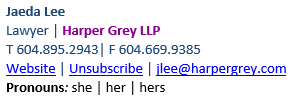Ready to start including your pronouns?
At the beginning of September, I authored a Dear LiL guest blog post that was focused on the importance of utilizing gender inclusive language in the office (ICYMI you can read that post here – I’ll see you when you get back 😉). In that post, I touched on the fact that we’ve started seeing an increase in people including personal pronouns in their email signature or on social media profiles and how these (seemingly) small gestures can go a long way towards normalizing inclusivity and lessening your chances of misgendering someone. Once my post went live, I started receiving messages of support in addition to questions as to how to format an e-signature line that contains your pronouns. So let’s say I’ve convinced you, and you’re ready to show your pronouns to the world – where do you start?
Most companies use a set e-signature which is formatted to their standards – so don’t just dive in and change it to reference pronouns. First, check with your IT or HR teams to ask whether it is an option to reference pronouns and if so, follow their process to update your e-signature. If they don’t already provide the option you may be challenged with a “why?”. Take that as a great opportunity to start a conversation about the importance of including them. And embrace the opportunity to be the first to raise the issue and spearhead your company’s move in this direction. In terms of responding to the “why?”, my previous post sets out how being aware of people’s pronouns and how societal attitudes about their use is changing is important to employers, employees, and clients. For example, more than likely there are individuals communicating with people within your company who are going to see the pronouns and feel included. Which is the goal.
Now that you’ve received approval to add your pronouns to your e-signature, the next step is to identify your own pronouns. As a recap, a pronoun is a word that refers to either the people talking (I or you) or someone or something that is being talked about (like she, it, them, and this). Gender pronouns refer to people that you are talking about. Gender neutral or gender inclusive pronouns are used when the individual being discussed does not associate with a gender. It’s up to you to determine where you fall on that spectrum.
She/her/hers and he/him/his
She/her/hers and he/him/his are a few commonly used pronouns. These are commonly referred to as “feminine” and “masculine” pronouns.
They/them/theirs
“Shane ate their food because they were hungry.”
This is a common gender-neutral pronoun and it can be used in the singular.
Ze/hir/hir
“Tyler ate hir food because ze was hungry.”
Ze is pronounced like “zee” can also be spelled zie or xe, and replaces she/he/they. Hir is pronounced like “here” and replaces her/hers/him/his/they/theirs.
Have a look at my email signature as one example of how pronouns can be included:

But it’s not the only way. You also can include your pronouns underneath your name, at the bottom of the signature, or – really – wherever it makes the most sense to you! See some examples below:
Shane Smith (he, him, his)
Director, Company
Vancouver BC
(123) 456.7890
Shane Smith
Director, Company
Vancouver BC
(123) 456.7890
Pronouns I use: he, him, his and they, them, theirs
Shane Smith
Director, Company
Vancouver BC
(123) 456.7890
I choose to share personal gender pronouns. My name is Shane and I use he, him, his pronouns. What pronouns do you use?
I hope you find this post helpful. If you have any further questions about how to include your pronouns in your e-signature let me know. Happy pronouning!